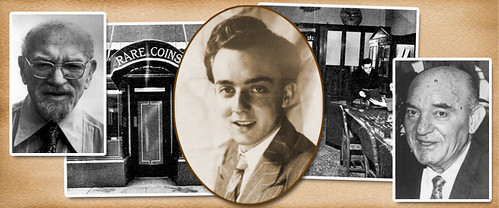
PREV ARTICLE
NEXT ARTICLE
FULL ISSUE
PREV FULL ISSUE
HARVEY STACK'S NUMISMATIC FAMILY, PART30Harvey Stack's blog series focuses on growing up in a numismatic family. Here is part 30. Nothing beats a report on numismatic events and personalities direct from someone who was there to witness them in person. Thanks, Harvey! -Editor  As with everything in the world, nothing remains the same. The coin business grew quite successfully in the decade of the 1950s as more collectors entered the field after World War II. People had more time and money to devote to their hobbies and build and maintain their collections. While things like television created a distraction taking time away from studying coins, those who had developed the collecting spirit continued to be attracted by building and completing collections. At the U.S. Mint, the 1950s saw Proof set mintages grow from about 50,000 to over three million sets. Speculation in such sets and Mint State rolls as a store of value had peaked and by the beginning of the 1960s the growth bubble had started to burst as the supply kept growing. The Treasury's new law to try and stop counterfeits from entering the country, mandated that all gold coins entering the U.S. must be licensed and examined. The Office of Gold and Silver Operations had to set up criteria as to what could be imported and what would not receive licensing. Imported gold coins had become a great source for building collections, and even among United States issues, there were many opportunities to purchase from overseas. Especially among $20 double eagles, quantities had been found in vaults where they had been hidden by the Axis powers. Many such coins had been sent overseas before World War II to pay United States debts and the value of such coins had risen above face value. But, importing United States coins was subject to the same regulations that had been put on all gold coin imports, making getting these coins to the United States more difficult and less desirable. The new regulations said that no license would be issued for any coin dated after 1933, an attempt to adhere to the Gold Act of 1933-4. The Treasury established a guideline for importing, in accordance with criteria that they created and did not reveal these rules to the importers or to the public. Because of this those who wanted to buy overseas never knew what would or would not be licensed. It became difficult to access important sources of coins from overseas. Old time collectors who had maintained their collections after the 1933-4 law, became afraid that the Treasury's policy of permitting gold collections would change and they might seize all gold coins in America. The 1930s gold law specifically exempted collector items made before 1933, but some numismatists still worried and some were discouraged from collecting until policies were clearer. Some even worried about putting their collections up for sale or auction. Collecting slowed down and many stopped buying for the time being. The market seemed to almost stop dead for part of the year of 1961. Stack's still received consignments, and had two major sales in 1961. The Howard Egolf Collection had been started by the consignor's father, with some of the series completed by the son. As he was getting older, the consignor was ready to see it sold. In addition, we were able to offer a world gold coin collection that had been built over many years. The collector wished to sell the collection while he was still alive, rather than leave it to be dealt with as part of his estate. What was a great help to us, was that we were able to buy foreign gold coins that were already in the United States from dealers and collectors nationwide and sell them to J.K. Lilly as he expanded his collection. And Mr. Lilly was able to acquire some very nice and rare coins at favorable prices, because some collectors had concerns about ownership in the current market. As 1961 came to an end, things began to turn around. A better understanding of the new import regulations led to a feeling of optimism as 1962 opened, and gave hope for a revival of interest in coins. To read the complete article, see: To read the earlier E-Sylum article, see: Wayne Homren, Editor The Numismatic Bibliomania Society is a non-profit organization promoting numismatic literature. See our web site at coinbooks.org. To submit items for publication in The E-Sylum, write to the Editor at this address: whomren@gmail.com To subscribe go to: https://my.binhost.com/lists/listinfo/esylum All Rights Reserved. NBS Home Page Contact the NBS webmaster 
|